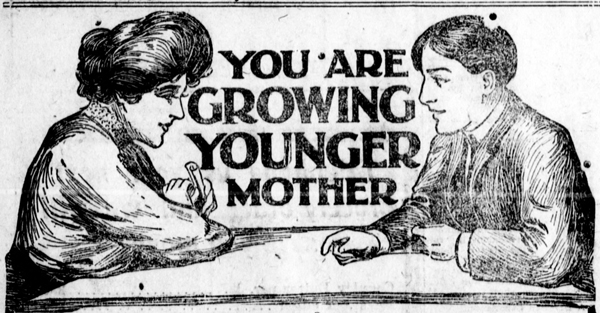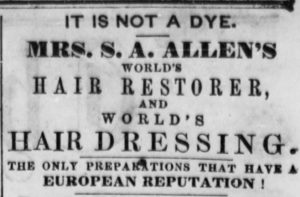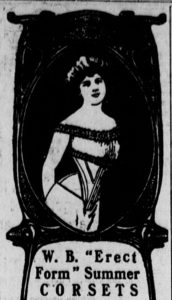How to Grow Younger

Each time period, culture and person has a unique idea of what makes something or someone beautiful—as the saying goes, “Beauty is in the eye of the beholder.” But no matter what specific qualities are used to define beauty, humans have undoubtedlybeen preoccupied with their physical appearance for thousands of years. Today we’ll explore how 19th and early 20th century products used newspaper advertisements to appeal to the very human desire to be beautiful.

For hair turning gray, Ohioans could turn to Mrs. S.A. Allen’s World’s Hair Restorer and World’s Hair Dressingwhich “restores gray hair to its natural color!” The products boast a “European reputation” and “contain no deleterious ingredients.” An entire column is dedicated to this ad, and most of it is comprised oftestimonials from Great Britain, Hayti (Haiti) and all over the United States by men and women alike. These “undeniable proofs” of the excellence of these products claim they “are perfect marvels” at restoring hair “to its natural glossy and beautiful black” and “original hue of youth.” What is this miracle product made of? The advertisement doesn’t say, but does assure you that Mrs. S.A. Allen’s hair restorer and zylobalsamum is worth every penny.
If her product isn’t suitable, G. Sechrist’s Hair Restorative, manufactured and sold in Akron, Ohio, also claims to restore gray hair: “Nothing adds more to the beauty of a human being than a fine head of hair.” Those looking to grow whiskers or a mustache can try Bellingham’s Celebrated Stimulating Onguentwhich “is warranted to bring out a thick set of whiskers or a mustache in from three to six weeks.” Other hair products include Carboline, Wyeth’s Sage and Sulphur Hair Remedy, Cranitonic, Rexalland Danderine—all intended to help, in some way, their users retain or regain a full head of hair.

Numerous skincare products advertised in newspapers promise to cleanse, purify, restore and otherwise leave skin looking and feeling beautiful. Nyal’s Face Cream Soapkeeps skin “clear, rosy, velvety and elastic” and comes recommended by famous actress Christie MacDonald. If the celebrity endorsement isn’t enough, Nyal’s claims that “it’s the pride of particular people–why don’t you use it?” Dike’s Peroxogen Creamis effective for “sun burned, irritated […] sallow, rough pimply and other skin affections”; Violet Dulce’s Complexion Powdercan be used to cover skin imperfections; and Hagan’s Magnolia Balm“gives a pure Blooming Complexion and restores Youthful Beauty.”

Ohioans, particularly women, concerned about their figures might look to W.B. “Erect Form” Summer Corsetsor “Stylish Stout” Corsetsto wear under their clothes. Ingestibles like Allan’s Anti-Fat, Reductoand a combination of Marmola, Fluid Extract Cascara Aromatic and Peppermint Water, all available at your local drug store, promise to help with weight loss.
Did these ads have your 19th or early 20th century self running out the door to your local drug store? Even if the beauty items themselves seem strange, the marketing techniques used are tried-and-true. Peer pressure, celebrity endorsements, laymen testimonials, competitive pricing, superlative language, focus on benefits, memorablegraphics and emotional appeal (to name just a few) encouraged contemporary readers to purchase these products and may feel eerily similar to what you see today on TV or the internet. If you’re interested in seeing more historic beauty product ads, and how they compare with today’s, try your own search on Chronicling America or Ohio Memory!
Thanks to Jenni Salamon, Coordinator for the Ohio Digital Newspaper Program, for this week’s post!



Leave a Reply
You must be logged in to post a comment.